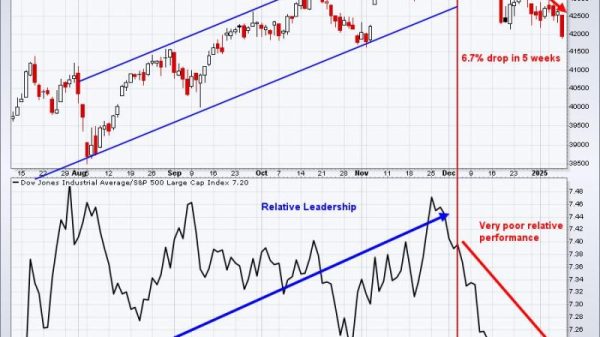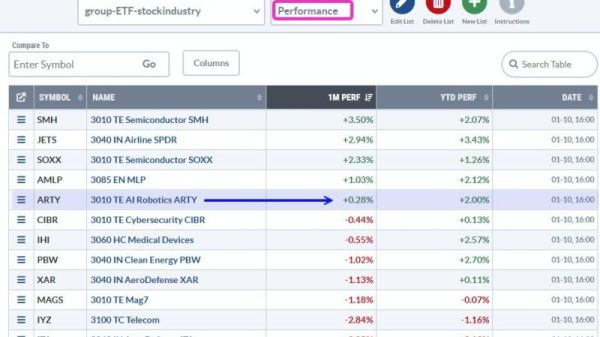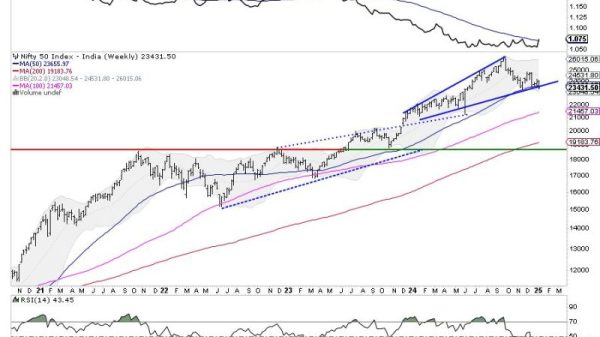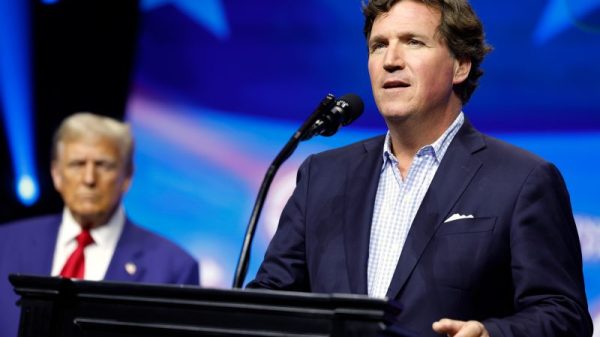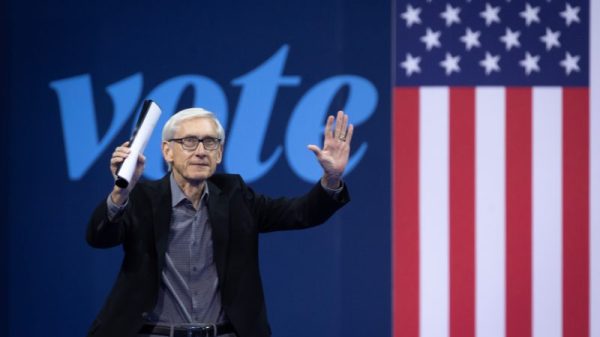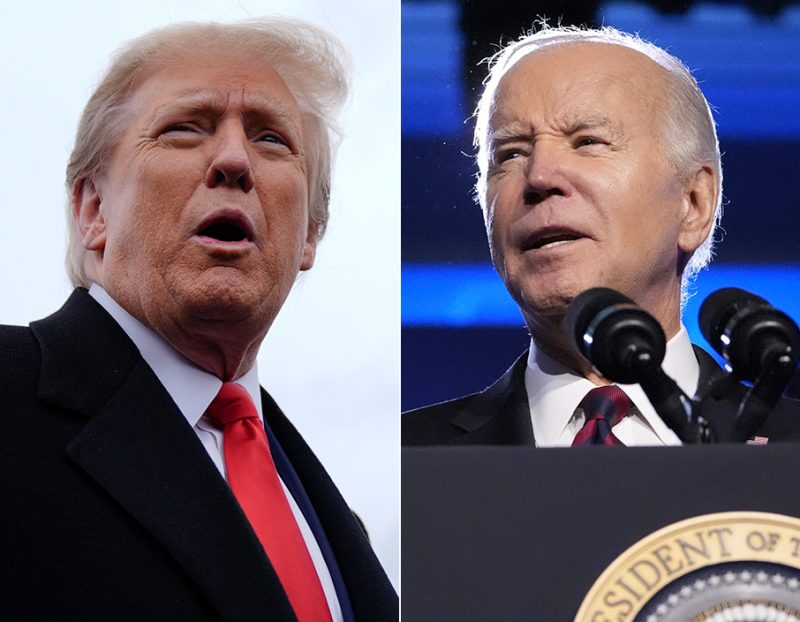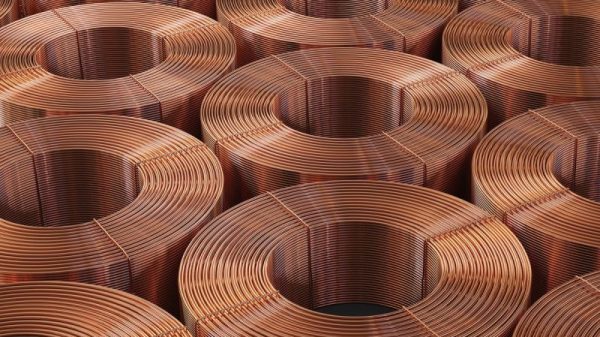“China is determined to dominate that market, with EV [electric vehicles] predominantly made in China and Chinese jobs. The previous administration was content to sit on the sidelines and let China take all these jobs, but I won’t let that happen. … In fact, when Donald Trump was in office, six auto factories closed around the country. Tens of thousands of auto jobs were lost nationwide during Trump’s presidency.”
— President Biden, in a speech to the United Auto Workers union, Jan. 24
“Biden has imposed the outlandish requirement that 67 percent of all new vehicles must be electric in less than 10 years. That means Michigan and places that make cars, you can forget about it. You better get your union working because you can forget about it. Those cars are all going to be made in China. … There’s no such thing as fair transition that destroys over 100,000 auto manufacturing jobs.”
— Former president Donald Trump, in a video address, Jan. 24
Get ready for the split-screen presidential election.
With Biden running for reelection and Trump seeking to get his old job back, voters will be bombarded with constant claims and counterclaims about each man’s record during his presidency.
When Biden addressed the UAW last week — and accepted its endorsement — he claimed Trump ignored China’s push into electric vehicles and lost auto industry jobs during his presidency. Trump, in turn, attacked Biden’s green energy policies designed to promote broader acceptance of electric vehicles, saying these policies will eliminate auto manufacturing jobs because China is going to dominate the market anyway. He accused the UAW — which reached contract agreements with auto manufacturers to ensure a transition to an EV world — of buying into myths about electric vehicles and urged workers to quit the union. “You should not pay your dues because they’re selling you to hell,” Trump said.
How do their records stand up?
Contrasting auto job records
Let’s first address the question of jobs — a data point easily found via the Bureau of Labor Statistics. Notice that Biden said “tens of thousands of auto jobs were lost nationwide during Trump’s presidency.” Technically, that’s right — if you include auto retail jobs. Those jobs declined 78,000 from February 2017 to February 2021, according to the bureau. Auto and auto parts manufacturing jobs saw a slight increase — 300 jobs — in the same period.
The White House uses the period from January 2017 to January 2021 to come up with a figure of 87,000 lost auto jobs under Trump, including nearly 9,000 manufacturing jobs. A president takes the oath of office Jan. 20. But for the Current Employment Statistics survey, employers report data to the Bureau of Labor Statistics for the pay period that includes the 12th of the month — before the new president takes office. So February, not January, would actually cover the first pay period after a new president is inaugurated. The bureau says there is no right or wrong way to do this, and economists differ on the best starting point. At The Fact Checker, we start counting the presidential job record with the February data.
Note that Trump’s job statistic includes 2020 — when the world was gripped by the coronavirus pandemic. The numbers change significantly if you date Trump’s job record from February 2017 to February 2020, just before the pandemic crashed the U.S. economy. That shows a gain of 34,100 auto manufacturing jobs and 36,400 auto retail jobs — for a total of more than 70,000 jobs in three years. That is a fairer way to look at Trump’s record on the auto industry.
But in early 2020 there were certainly signs of stress in auto manufacturing. It’s largely forgotten now, but the U.S. economy was slipping just before the pandemic, despite Trump’s constant bombast that he had created the best economy ever. Nearly 26,000 auto manufacturing jobs were lost from February 2019 to February 2020, indicating that the manufacturing sector was in a recession in 2019. Biden is correct that six manufacturing plants were closed — all before the pandemic.
Biden now has been president almost as long as Trump was when the pandemic emerged. The most recent Bureau of Labor Statistics data is from December 2023, and Biden so far fares much better in a direct comparison of the first three years. Almost 125,000 auto manufacturing jobs have been created and 129,000 auto retail jobs, for a gain of nearly 254,000 during Biden’s presidency.
Biden vs. Trump on electric cars
Biden is correct that Trump did not encourage electric-vehicle production or seek to counter China’s big investment in the technology. Trump would sometimes joke — falsely — about how little an electric vehicle could travel on a single charge. He proposed to eliminate programs that encouraged the manufacture or purchase of an electric vehicle and proposed no legislation designed to encourage EV manufacturing in the United States.
Even now that the European Union has mandated the sale of only zero-emission new cars by 2035, Trump seems rooted in fossil-fuel technology, complaining in his video address that “we sit on liquid gold and we’re getting rid of combustion engines.” He questions whether the United States would make the batteries that power EVs, giving China the edge.
The Chinese government has given huge subsidies to the EV industry in a quest to dominate it. In the final quarter of 2023, the Chinese firm BYD — which once just made cellphone batteries — surpassed Tesla as the world’s biggest manufacturer of vehicles powered only by batteries.
Biden administration officials point to laws passed during his presidency to counter China’s rise in the EV market: the Bipartisan Infrastructure Law ($7.5 billion to promote EV charging, including building a network of high-speed chargers); the Chips and Science Act (which provides $39 billion in semiconductor manufacturing incentives, including $2 billion for older chips used in automobiles and defense systems) and the Inflation Reduction Act, or IRA, (which provides tax credits for EVs and incentives to encourage domestic battery production).
As a result, automakers have invested billions of dollars in electric-vehicle and battery manufacturing. A report issued by the Environmental Defense Fund in August said $93 billion of announced EV investments and nearly 85,000 in announced jobs took place in the 12 months after passage of the Inflation Reduction Act. In a December research report, Goldman Sachs said that as a result of that law, the United States could be self-sufficient in EV battery production — including mining, components and battery production — by 2030.
Biden in April proposed tough emission standards that could mean two out of every three new vehicles that automakers sell will be electric within a decade. The Energy Department says it will assist with the conversion to electric vehicles with $2 billion in grants and $10 billion in loans to automakers and suppliers.
Contrary to Trump’s statement that Biden has already imposed a mandate, the Environmental Protection Agency has not issued a final regulation. Auto dealers have written Biden that there is an oversupply of EVs and they won’t be able to meet the proposed requirements.
EV sales have increased for 14 straight quarters, according to Cox Automotive, which owns the auto research and valuation company Kelley Blue Book, but still account for only 7.6 percent of total sales. “The EV market in the U.S. is still growing, but not growing as fast,” Cox said, predicting the EV share may top 10 percent this year.
As for Trump’s claim that the transition to mostly EV sales will result in the loss of 100,000 jobs, a Trump spokesman did not respond to repeated queries asking for the source of this claim. We think Trump may be referring to a 2021 report by the Economic Policy Institute, which said that in the transition to EV sales, the auto industry could lose 75,000 jobs without sufficient government investment.
“In terms of setting up the U.S. auto sector to thrive in the EV transition, I’d argue that the IRA has absolutely done a lot to move us well away from the ‘base case’ scenario in 2021 that would’ve seen a large number of jobs lost,” said Josh Bivens, co-author of the report and chief economist at the institute. “The Biden administration is indeed on track to prevent those job losses.”
Biden’s record on electric vehicles holds up well in comparison to Trump’s. He can point to three major laws that have been passed that seek to encourage EV sales and promote domestic semiconductor and battery production. Auto jobs have boomed under Biden, with auto manufacturing jobs at their highest point since 2006. He’s placed a big bet that the United States will transition to mostly EV sales in the next decade, just as Europe and China have. Whether that bet pays off — and whether the auto industry can weather the transition without major dislocation — remains to be seen.
Trump, meanwhile, as president largely ignored growing consumer interest in electric vehicles. He rails that Biden’s actions to promote EV will result in major job losses — and that China will win the EV race in any case. He offers no evidence for his claims, and it’s a strangely passive response for someone who during his presidency constantly warned about the U.S. trade deficit with China.
(About our rating scale)
Send us facts to check by filling out this form
Sign up for The Fact Checker weekly newsletter
The Fact Checker is a verified signatory to the International Fact-Checking Network code of principles





